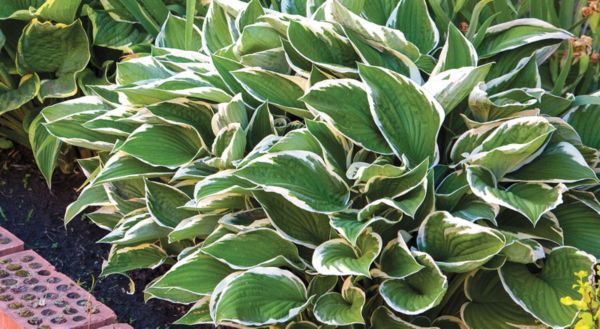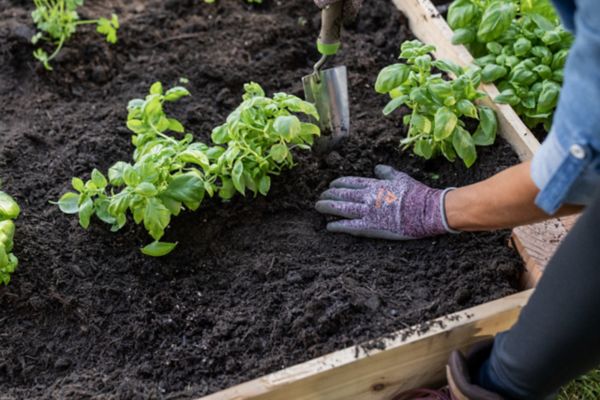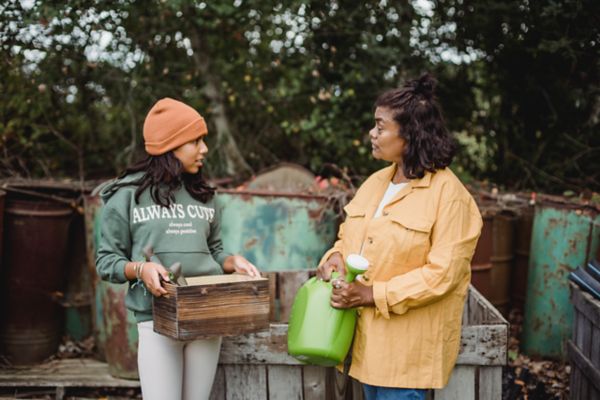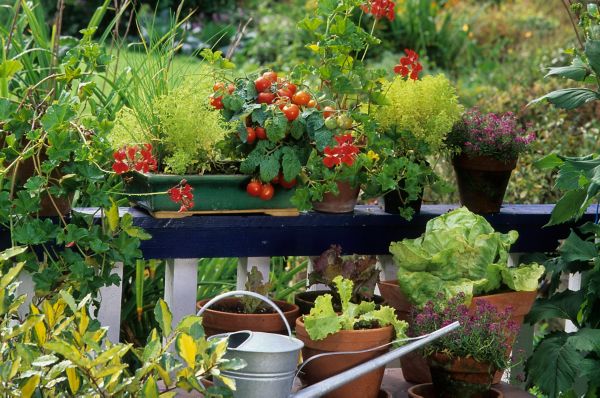How to Grow Basil
Authored by Leah Chester-Davis
Basil is an easy, quick-growing herb and will reward you with delicious flavor all season long. It’s easy to snip off a few leaves as needed to flavor culinary dishes. Basil is a popular plant to tuck into flower borders or other spots in your landscape.
Basil is an easy herb to grow and its flavor complements numerous dishes, from fresh tomatoes to soups, sauces, and pizza. It is a main ingredient in pesto, which is delicious on pasta dishes, sandwiches, meat, and a variety of vegetables. Grown for its flavorful leaves, basil will thrive in garden rows, raised beds, or in containers. You do not need a lot of room to grow this versatile herb. A sunny spot on a patio will do just fine.
About basil
| Botanical name: | Ocimum basilicum |
| Common name: | Basil |
| Plant type: | Tender annual |
| Size: | Ranges from a few inches to 2- to 3-feet tall, depending on the type and variety |
| Sun exposure: | Full sun |
| Soil type: | Rich, well-drained soil |
| Soil pH: | 6 to 6.5 |
| Hardiness zones: | Numerous zones; your zone may dictate variety |
| Average first frost: | Varies by region |
| Average last frost: | Varies by region |
| Container friendly: | Yes |
| Beginner friendly: | Yes |
Growing

Basil is an easy, quick-growing herb and will reward you with delicious flavor all season long. It’s easy to snip off a few leaves as needed to flavor culinary dishes. Basil is a popular plant to tuck into flower borders or other spots in your landscape.
Basil needs full sun, at least six hours per day.
With any gardening endeavor, it helps to have your soil tested to determine the soil pH and whether you need to add any amendments. The soil pH needs to be between 6 and 6.5, the typical range for most vegetables.
There are four types of basil with numerous cultivars in each category.
- Sweet basil: The large-leaved variety, ‘Genovese’, is one of the most common sweet basils in seed catalogs and local stores. It’s a staple in Italian cooking, and a great choice if you’re interested in making pesto periodically through the season. It grows to a large size, 2-feet tall and more.
- Small-leaved or dwarf basil: These types grow in compact forms, reaching only 6- to 12-inches tall. ‘Spicy Globe’ is a popular variety and its name gives a clue to its flavor, which is a bit spicier than other basils. ‘Marseilles’ is a French variety, which is favored for it delicious flavor. Any of these basils grow well in containers.
- Purple basil: While purple may not be the color you think of when it comes to basil, purple varieties can add interest to the garden and can be grown both for the flavorful leaves and as an accent plant. ‘Purple Ruffles’ has ruffled, fringed foliage that provides a striking contrast and appealing scent in container gardens. Its leaves can be used in salads, herb vinegars, and other culinary creations.
- Specially scented basil: Numerous varieties are available that have both fragrance and flavor beyond the typical basil plants. Among them are cinnamon, lemon, lime, and sweet Thai basil, which is a great variety to grow if you enjoy preparing Asian cuisine.
Basil can be grown from seeds or from transplants.
Planting

Basil can be grown from seeds or from transplants. If you start your plants from seeds, sow the seed indoors in a seed-starter mix 4- to 6-weeks before planting outdoors after frost. If seeding outdoors, wait until danger of frost has passed. Plant the seeds about ¼-inch deep and keep the soil moist. They should germinate in 5 to 10 days. If you do not wish to start plants from seeds, local garden centers are great places to find transplants in the spring. Wait until after the last frost date in your area and when temperatures are in the 70s before planting outside.
Basil needs rich, well-drained soil. Mix plenty of organic matter such as compost or aged manure into your garden beds before planting. Space plants about 12 inches apart to give plants plenty of air circulation. Keep plants evenly watered in well-drained soil without allowing to dry out. Basil does not like soggy conditions.
If growing basil in a container, use a potting mix that is blended for growing herbs and vegetables. Avoid using garden soil, which can become too heavy and not drain well in containers.
When plants are about 6-inches tall, pinch the growing point back an inch or so to encourage branching and thicker growth. As the plant grows it will begin to produce white, pink, or purple blooms on terminal spikes. Pinch off these blooms to keep the plant producing the leaves.
A healthy plant will produce leaves through the season. If you wish to pick enough leaves to make pesto through the summer, plant at least three plants.
Fertilizing
- Fertilize sparingly. Basil does not need a lot of fertilizer and too much can affect flavor.
- Minnesota Extension recommends using a 5-10-5 fertilizer once or twice during the growing season at the rate of 3 ounces per every 10 foot of row. If growing in containers, use a liquid fertilizer at one-half the label-recommended strength every four to six weeks for indoor plants and every three to four weeks for basil grown outside.
Controlling Pests, Diseases, and Other Problems
Basil is susceptible to Fusarium wilt. Look for varieties that are resistant, which will be available from seed companies and likely your local garden center. Gray mold, bacterial wilt, leaf spots, downy mildew, and root rots are other diseases. Follow these good cultural practices to lessen problems.
- Start with healthy soil and healthy plants.
- Remove and dispose of any infected plants.
- Avoid harvesting on rainy days.
- Water at the base of the plant instead of overhead watering to reduce foliar diseases.
- Space plants apart to allow good air circulation and to allow leaves to dry properly after rainfall and morning dew.
- Make sure the soil has adequate drainage.
- At first sign of diseased foliage, pull leaves off plant and dispose. If minor disease persists, consider treating with a fungicide or an organic product but read label directions carefully to ensure the product you use is suitable for basil.
- Rotate as needed in the garden and avoid planting where tomatoes may have had wilt problems as bacteria can remain in the soil.
Common Pests for Basil
Some common insect pests are aphids, slugs, spider mites, whiteflies, and Japanese beetles.
- Pick off the Japanese beetles and crush or drop into a bucket of soapy water.
- For other insects, Clemson Extension recommends using an insecticidal soap or azadiractin product, which is a natural product extracted from Neem trees, and available at most garden centers. Follow label directions. Pay close attention to the underside of leaves where insects like to hang out.
- While mulch can be helpful in keeping moisture levels even and cut down on weeds, it can provide a hiding place for slugs. If needed, sprinkle diatomaceous earth over the mulch around the plants or use slug baits.
Harvesting and Storing

Basil will not last past the first frost so plan on harvesting before that date. If you are growing basil in containers, consider moving them inside to a sunny window. Harvest as needed though frequent harvesting of leaves keeps the plant producing. Harvest in the morning after the dew has dried. The best way to harvest basil is to pinch or cut the whole stem just above two to three sets of leaves.
Each time you harvest, leave enough foliage so the plant will continue to grow. Remove no more than about 1/3 to ½ of the plant at any one harvest.
Storing
Basil is best used soon after harvest. The cut stems can be placed in water like a flower bouquet to enjoy on your kitchen counter and to pick from as you cook. Use within 3 to 5 days. Or wrap basil in dry paper towels, place in a plastic bag or container that has air vents or holes, and store in the refrigerator. Use within a couple of days.
A popular way to enjoy its flavor through the year is to make a pesto and then freeze by filling ice cube trays with the pesto mixture. When frozen, the individual cubes can be placed together in freezer bags to make it easy to retrieve one or two cubes to toss into soups or sauces.
An alternative to the pesto is to puree the leaves in a blender with a small amount of water or vegetable or olive oil. Freeze the mixture in the ice cube trays and then move the individual cubes to freezer bags.
Basil can also be air-dried, oven-dried, or dried in a food dehydrator. When dry, crumble the leaves and store in an air-tight container.
A popular way to enjoy its flavor through the year is to make a pesto and then freeze by filling ice cube trays with the pesto mixture.
Expert Tips

- Water at the base of the plants to reduce chances of disease.
- Plants in containers dry out more quickly than those in garden beds. Water them more frequently.
- Unless you are growing basil for ornamental purposes, do not allow it to flower as this results in plants becoming woody and can affect the flavor. Pinch off the flower blooms and stems.
Frequently asked questions
Can I grow basil near my tomatoes?
Basil and tomatoes are great companion plants, both in the garden and in culinary dishes. The only time to be concerned when planting basil near tomatoes is if tomatoes in the previous few seasons have had any type of bacterial wilt. The bacteria can remain in the soil. It is best to rotate crops, which means plant both your tomatoes and basil in a different spot in the garden.
Can I root more basil plants from cuttings?
Yes, you can propagate basil by cutting about 4-inch tips from your plants, rooting in water, and then transplanting to soil.
Are there any basil varieties resistant to downy mildew?
Downy mildew has been a problem in recent years. Look for ‘Prospera’, ‘Pesto Party’, and ‘Amazel Basil’. Rutgers University has introduced several downy mildew resistant (DMR) varieties. ‘Devotion’, Obsession’, ‘Passion’ and ‘Thunderstruck’ are a few. Some of the specialty scented basils such as lemon basil seems to have more resistance than the sweet basils. If you can’t find any of the DMR varieties, keep in mind that good cultural practices help reduce chances of disease and insect problems: good, healthy, well-drained soil, good air circulation, and watering at the base of the plant so leaves don’t stay wet.






